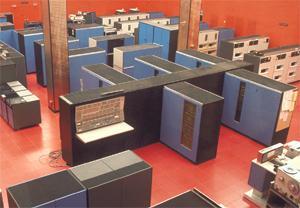
In 1971, a series of "mysterious" cabinets (such as the one illustrated by the graphic on the left) were housed in a large 6 story building known as "The Computer Center" at the University of Waterloo. These cabinets were in a football field size room that was two stories high, and one viewed them by looking down through a bank of ceiling to floor windows on the second floor. The cabinets sat on a red tile floor, and the walls were also painted red - thus the room was called "The Red Room".
1971 was the year the Museum began, and like other units of the University, the Museum was given access to "The Computer". Museum staff knew little about computing at the time, and was not sure of the value that access to "The Computer" would have for the Museum, particular with respect to games!

Access to computing at that time was via a series of typewriter-like floor standing machines (photograph at the right) situated in different parts of the Computer Center and wired directly into the "mysterious" cabinets. Installed in the typewriter device was a box of continuous-feed paper. At some point in the early 1970s someone showed Museum staff members how to use these typewriter machines to play a game "with or against" the computer.
The game was called "Adventure". A player would type in some information to let the computer "know" that the player had permission to use the computer, and then the player would indicate that he wished to play "Adventure". The computer would type out a sentence like "You are in a large cave with a number of smaller passages going off in different directions.." Then the typing would stop and the computer would wait until the player responded by typing in some information, such as "GO NORTH ". The computer might then respond "You have walked into a wall of stone!" The player might then type "REVERSE" and the computer might respond "I don't understand that." Thinking about this for a while, the player might reply "TURN AROUND", and the game would go on like this until the player became exhausted.

While this game and some others did not change much in the next few years, the equipment that one used to play the game did change. Cathode Ray Tubes (CRT) in metal cases (like the type used in commercial television sets) began to replace the paper fed typewriter devices, with a typewriter keyboard sitting below the CRT. However, computing was still "text based" at this time, and instead of typing "I don't understand that.." on paper, the computer typed it on the screen. The player would respond by typing on the typewriter key board sitting in front of the CRT. Both the CRT and the keyboard were wired directly into the computer.

As computer applications developed during the 1970s, the University "stretched" wires from the Computing Center to other buildings on campus and thus it became possible to compute from a number of locations. Then in the late 1970s, telephone communication modems were added, and it became possible to "compute" not only from many places on campus, but from off-campus as well. The photograph at the right is of the "Red Room" in 1974 - the many mysterious cabinets that "talked" to one another and were what we called "the computer"!
With respect to the Museum collection, some lines of Mainframe computer code have been retained to commemorate these early computer games. Others on the Internet also remember these games. Thus, for historic information about "Adventure" you can go to: Colossal Cave Adventure. Here is another Internet site that will actually let you play this game today on your personal computer: Play ADVENTURE. (You will need to use your "BACK" button to return to the Museum page.)
Last update March 22, 2010